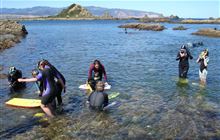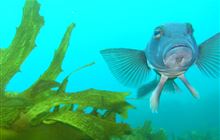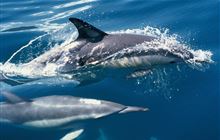Is Wellington home to a new biodiversity hotspot?
Archived content: This media release was accurate on the date of publication.
Introduction
Citizen scientists have recorded nearly 2,000 observations at Wellington's Taputeranga Marine Reserve.Date: 13 February 2019
More marine species have been recorded by citizens at Wellington's South Coast marine reserve than in New Zealand's most internationally famous dive destination the Poor Knights Islands Marine Reserve.
Nearly two thousand observations have been reported by citizen scientists in the ten-year-old Taputeranga Marine Reserve, as part of an online project hosted by iNaturalist. Curated by DOC marine scientists, the project has clocked up nearly 350 recorded species in Taputeranga, compared to less than 200 for the Poor Knights.
Knowledge of what's in our oceans is low compared to that of dry land, but marine scientists estimate that as much as 80 percent of New Zealand's indigenous biodiversity is found in the sea. While many of our marine fish are found in other countries' seas, many of our benthic (bottom dwelling) marine species are found only in New Zealand.
Clinton Duffy, Technical Advisor for DOC's Marine Ecosystems team, says that it is unclear why there is such a difference between observations at the Wellington site and those in eight other marine reserves, including the sub-tropical Poor Knights.
"None of these other projects have had anywhere near the number of observations posted in Taputeranga, despite active promotion and higher populations in the Auckland region.
"One credible theory is that there are just more nature geeks in Wellington!
"The truth is, it probably reflects Taputeranga's urban location, including its proximity to Victoria University, the National Institute of Water and Atmospheric Research and several dive shops."
Whatever the reason, there is no doubt that photographs coming out of the marine reserve and reported to iNaturalist highlight the stunning marine life that occurs off Wellington's south coast.
Some of the unusual finds include a rare deep-water species called a half-naked hatchetfish, (argyropelecus hemigymnus), and the hula skirt siphonophore (physophora hydrostatica), a relative of jellyfish and corals.
Colin Ryder, Chair of Friends of Taputeranga Marine Reserve, says his group has always felt that Taputeranga is more ecologically interesting and diverse than its better-known northern counterparts.
He says there is still much more to find as some areas of the reserve are yet to be covered.
"The scary thing is that intertidal organisms dominate the records, and coverage of the deepest parts of the reserve is almost non-existent. So we're probably just scratching the surface - in manner of speaking!"
Species usually harvested for food, such as paua, rock crayfish, blue moki, tarakihi and blue cod, appear to be thriving in the marine reserve, judging by the size and number seen in some of the images sent to iNaturalist. Large schools of trevally are also being photographed.
"This is proof that when fully protected, even for as little as 10 years, marine environments can recover and flourish."
Colin is encouraging Wellingtonians and visitors to have a look for themselves.
"Go to the iNaturalist NZ website to get inspired. Then visit the marine reserve, get into the water and go exploring with a camera so you can post your photos and help discover what's hiding in the deep."




